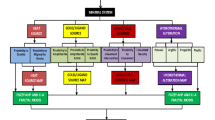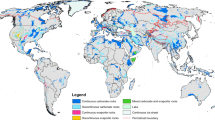Abstract
The exploitation of granite resources and the consequent processing create several economic opportunities that provide the creation of infrastructures and services. This flourishing activity is based on the available resources which need to be identified and protected through an effective land use planning. In this study, the evaluation of the granite resources in an exploitation area was performed. The fracturing and the quality of the outcrops are fundamental factors to be considered during ornamental stone exploration, but for the evaluation of the available resources, land use planning constraints should be considered. All the collected data were processed in a geographic information system to determine the potential extractive areas. Considering the several limitations, namely active quarries and legal constraints, only 41.3% of the study area can be used for installing new quarries. Considering the fracturing limitations, these new quarries, with a mean depth and mean deposit yield of 12.5 m and 12.5%, respectively, will supply about 2.67 × 106 m3 of granite. The results highlight the importance of an integrated evaluation of the natural stone resources since large areas not necessarily mean abundant resources.







Similar content being viewed by others
References
Akanwa AO, Okeke FI, Nunodu VC, Iortyom ET (2017) Quarrying and its effect on vegetation cover for a sustainable development using high-resolution satellite image and GIS. Environ Earth Sci 76:505. https://doi.org/10.1007/s12665-017-6844-x
Allmedinger RW, Cardozo NC, Fisher D (2013) Structural geology algorithms. Vectors and tensors. Cambridge University Press, Cambridge
Aubynn A (2009) Sustainable solution or a marriage of inconvenience? The coexistence of large-scale mining and artisanal and small-scale mining on the Abosso Goldfields concession in Western Ghana. Resour Policy 34:64–70. https://doi.org/10.1016/j.resourpol.2008.04.002
Barakat A, Ouargaf Z, Touhami F (2016) Identification of potential areas hosting aggregate resources using GIS method: a case study of Tadla-Azilal Ragion, Morocco. Environ Earth Sci 75:774. https://doi.org/10.1007/s12665-016-5613-6
Carvalho JF, Henriques P, Falé P, Luís G (2008) Decision criteria for the exploration of ornamental-stone deposits: application to the marbles of the Portuguese Estremoz Anticline International. J Rock Mech Min Sci 45:1306–1319
Carvalho JMF, Lisboa JV, Moura AC, Carvalho C, Sousa LMO, Leite MM (2013) Evaluation of the Portuguese ornamental stone resources. Key Eng Mat 548:3–9
Cruden DM (1977) Describing the size of discontinuities. Int J Rock Mech Min Sci Geomech Abstr 14:133–137
Dahl TW, Clausen AU, Hansen PB (2011) The human impact on natural rock reserves using basalt, anorthosite, and carbonates as raw materials in insulation products. Int Geol Rev 53(8):894–904
Decreto-Lei 90/90 (1990) Diário da República, No. 63—1ª Série, 1990-03-16
Decreto-Regulamentar 6 (2009) Diário da República, No. 65—1ª Série, 2009-04-02
Elci H, Turk N (2014) Block volume estimation from the discontinuity spacing measurements of Mesozoic Limestone Quarries, Karaburun Peninsula, Turkey. Sci World J 2014:363572. https://doi.org/10.1155/2014/363572
Galetakis M, Soultana A (2016) A review on the utilisation of quarry and ornamental stone industry fine by-products in the construction sector. Constr Build Mater 102:769–781. https://doi.org/10.1016/j.conbuildmat.2015.10.204
Garcia EO (1996) Investigacion de yacimientos. In: Jimeno CL (ed) Manual de rocas ornamentales. Entorno Grafico, Madrid, pp 139–174
Gómez-Márquez I,.Alejano LR, Bastante FG (2011) Mining compatibility with other projects in Spain: Solutions and benefits. Resour Policy 36:22–29. https://doi.org/10.1016/j.resourpol.2010.07.001
Häggquist E, Söderholm P (2015) The economic value of geological information: synthesis and directions for future research. Resour Policy 43:91–100. https://doi.org/10.1016/j.resourpol.2014.11.001
IGM (2000) In: Pereira E (Ed) Geological map of Portugal, 1:200000 Scale. Instituto Geológico e Mineiro, Lisbon
ISRM (1981) Basic geotechnical description of rock masses. International Society of Rock Mechanics, Commission on the Classification of Rock and Rock Masses. Int J Rock Mech Min Sci Geomech Abstr 18:85–110
Lavee D, Bahar S (2017) Estimation of external effects from the quarrying sector using the hedonic pricing method. Land Policy 69:541–549. https://doi.org/10.1016/j.landusepol.2017.10.005
Lawer ET, Lukas MC, Jørgensen SH (2017) The neglected role of local institutions in the ‘resource curse’ debate. Limestone mining in the Krobo region of Ghana. Resour Policy 54:43.52. https://doi.org/10.1016/j.resourpol.2017.08.005
Macedo D, Junior RM, Mizusaki AMP (2017) Sustainability strategies for dimension stones industry based on Northwest region of Espírito Santo State, Brazil. Resour Policy 52:207–216
Morais AIF (2003) Inventariação, caracterização e valorização das pedreiras do granito Amarelo Real. MSc thesis, University of Trás-os-Montes e Alto Douro
Morales-Demarco M, Oyhantçabal P, Stein K-J, Siegesmund S (2011) Black dimensional stones: geology, technical properties and deposit characterization of the dolerites from Uruguay. Environ Earth Sci 63:1879–1909
Mosch S, Nikolayew D, Ewiak O, Siegesmund S (2011) Optimized extraction of dimension stone blocks. Environ Earth Sci 63:1911–1924
Mustafa S, Khan MA, Khan MR, Sousa LMO, Hameed F, Mughal M, Niaz A (2016) Building stone evaluation—a case study of the sub-Himalayas, Muzaffarabad region, Azad Kashmir, Pakistan. Eng Geol 209:56–69. https://doi.org/10.1016/j.enggeo.2016.05.007
Ogan DD, Ndekugri IE, Oduoza CF, Khatib JM (2016) Principles for developing an effective framework to control minerals and rocks extraction impacts, mitigate waste and optimise sustainable quarries management. Resour Policy 47:164–170. https://doi.org/10.1016/j.resourpol.2016.01.004
Palmström A (1982) The volumetric joint count - a useful and simple measure of the degree of jointing. In: Proceedings of the 4th international congress of IAEG, pp. 221–228, New Delhi, India
Prno J (2013) An analysis of factors leading to the establishment of a social licence to operate in the mining industry. Resour Policy 38:577–590. https://doi.org/10.1016/j.resourpol.2013.09.010
Ramos JMF, Moura AC, e Grade J (1989) A fraturação dos maciços de rochas ornamentais—sua importância técnico-económica. Rochas Equip 16:66–79
Rustad SA, Billon PL, PLujala P (2017) Has the extractive industries transparency initiative been a success? Identifying and evaluating EITI goals. Resour Policy 51:151–162. https://doi.org/10.1016/j.resourpol.2016.12.004
Santos ICA (2016) Ordenamento das zonas extrativas de granito no concelho de Vila Pouca de Aguiar – Um estudo na Área de Reserva da Serra da Falperra. MSc thesis, University of Trás-os-Montes e Alto Douro
Simão J, Carvalho C, Silva Z, Moura AC (2010) Fator de qualidade em rochas ornamentais com base em ensaios mecânicos e envelhecimento artificial. Geotecnia 119:97–109
Sousa LMO (2000) Estudo da fraturação e das características físico-mecânicas de granitos da região de Trás-os-Montes com vista à sua utilização como rocha ornamental. PhD thesis, University of Trás-os-Montes e Alto Douro
Sousa LMO (2007) Granite fracture index to check suitability of granite outcrops for quarrying. Eng Geol 92:146–159
Sousa LMO (2010) Evaluation of joints in granitic outcrops for dimension stone exploitation. Q J Eng Geol Environ 42:85–94
Sousa LMO (2014) Petrophysical properties and durability of granites employed as building stone: a comprehensive evaluation. Bull Eng Geol Environ 73(2):569–588. https://doi.org/10.1007/s10064-013-0553-9
Sousa LMO, Gonçalves BMM (2012) Color assessment of granitic rocks and implications for their ornamental utilization. Color Res Appl 37:375–383
Sousa LMO, Suárez del Río LM, Calleja L, Ruiz de Argandoña V, Rey AR (2005) Influence of microfractures and porosity on the physico-mechanics properties and weathering of ornamental granites. Eng Geol 77:153–168
Sousa LMO, Oliveira AS, Alves IMC (2013) Assessing fracturing in weathered granites: the example of the Mondim de Basto granite (Northern Portugal). Key Eng Mat 548:48–54
Sousa LMO, Oliveira AS, Alves IMC (2016) Influence of fracture system on the exploitation of building stones: the case of the Mondim de Basto granite (north Portugal). Environ Earth Sci 75:39. https://doi.org/10.1007/s12665-015-4824-6
Sousa LMO, Barabasch J, Stein K-J, Siegesmund S (2017) Characterization and quality assessment of granitic building stone deposits: a case study of two different Portuguese granites. Eng Geol 221:29–40
Streckeisen AL (1967) Classification and nomenclature of igneous rocks. Final report of an inquiry. Abh Neues Jahrb Mineral 107:144–240
Vintró C, Fortuny J, Sanmiquel L, Freijo M, Edo J (2012) Is corporate social responsibility possible in the mining sector? Evidence from Catalan companies. Resour Policy 37:118125. https://doi.org/10.1016/j.resourpol.2011.10.003
Yarahmadi R, Bagherpour R, Taherian S-G, Sousa LMO (2018) Discontinuity modelling and rock block geometry identification to optimize production in dimension stone quarries. Eng Geol 232:22–33
Zvarivadza T (2018) Sustainability in the mining industry: an evaluation of the national planning commission’s diagnostic overview. Resour Policy. https://doi.org/10.1016/j.resourpol.2018.01.008
Author information
Authors and Affiliations
Corresponding author
Additional information
This article is part of a Topical Collection in Environmental Earth Sciences on “Stone in the Architectural Heritage: from quarry to monuments—environment, exploitation, properties and durability”, guest edited by Siegfried Siegesmund, Luís Sousa, and Rubén Alfonso López-Doncel.
Rights and permissions
About this article
Cite this article
Santos, I., Sousa, L. & Lourenço, J. Granite resource evaluation: example of an extraction area in the north of Portugal. Environ Earth Sci 77, 608 (2018). https://doi.org/10.1007/s12665-018-7780-0
Received:
Accepted:
Published:
DOI: https://doi.org/10.1007/s12665-018-7780-0




